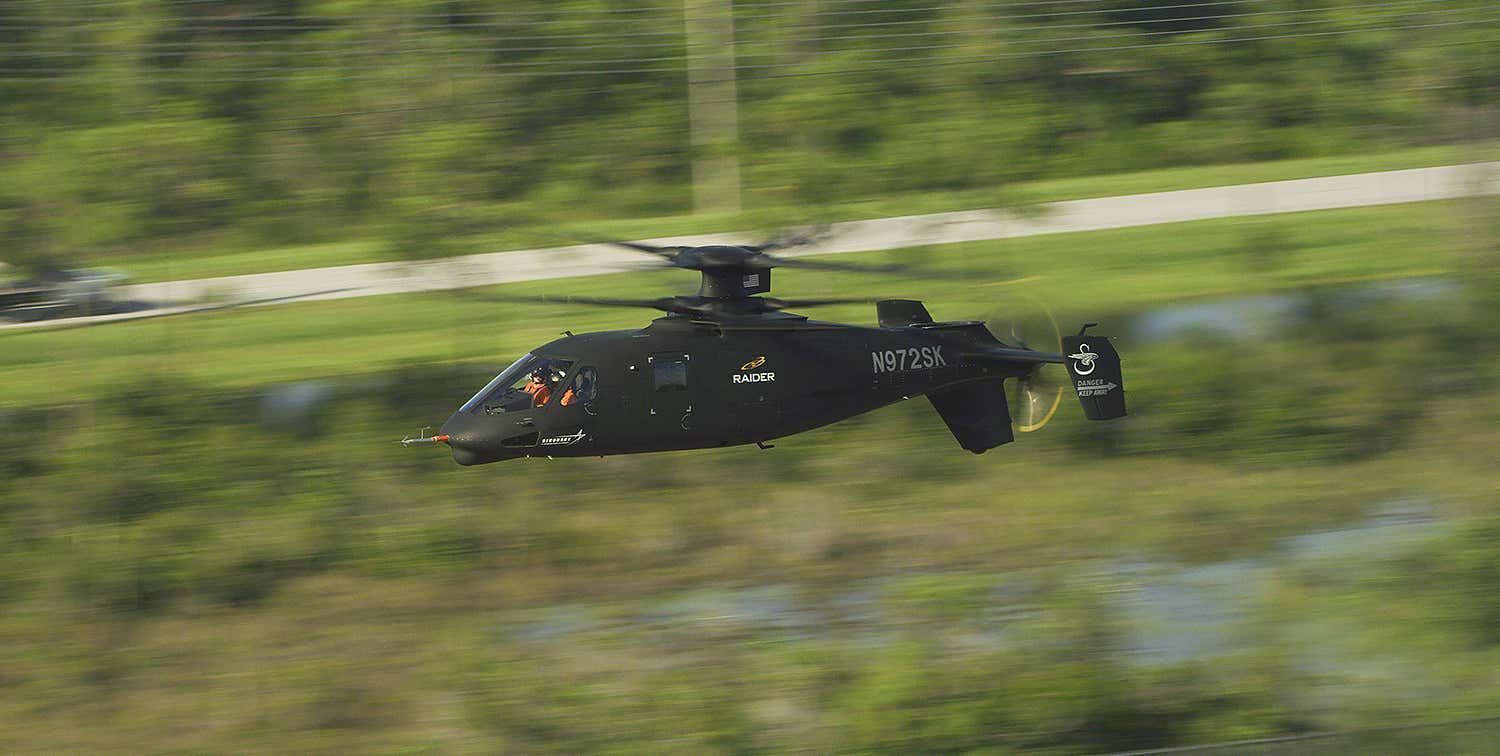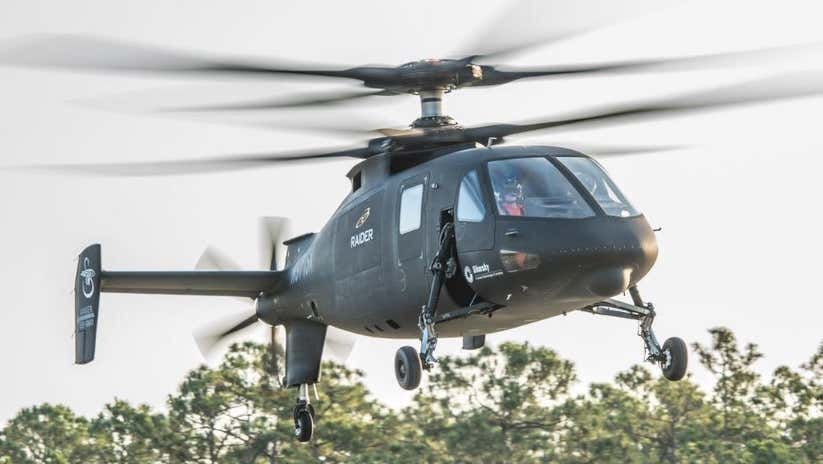Sikorsky is betting huge on its X2 technology, but there's still much to understand about it and how they see it as the future of vertical lift.
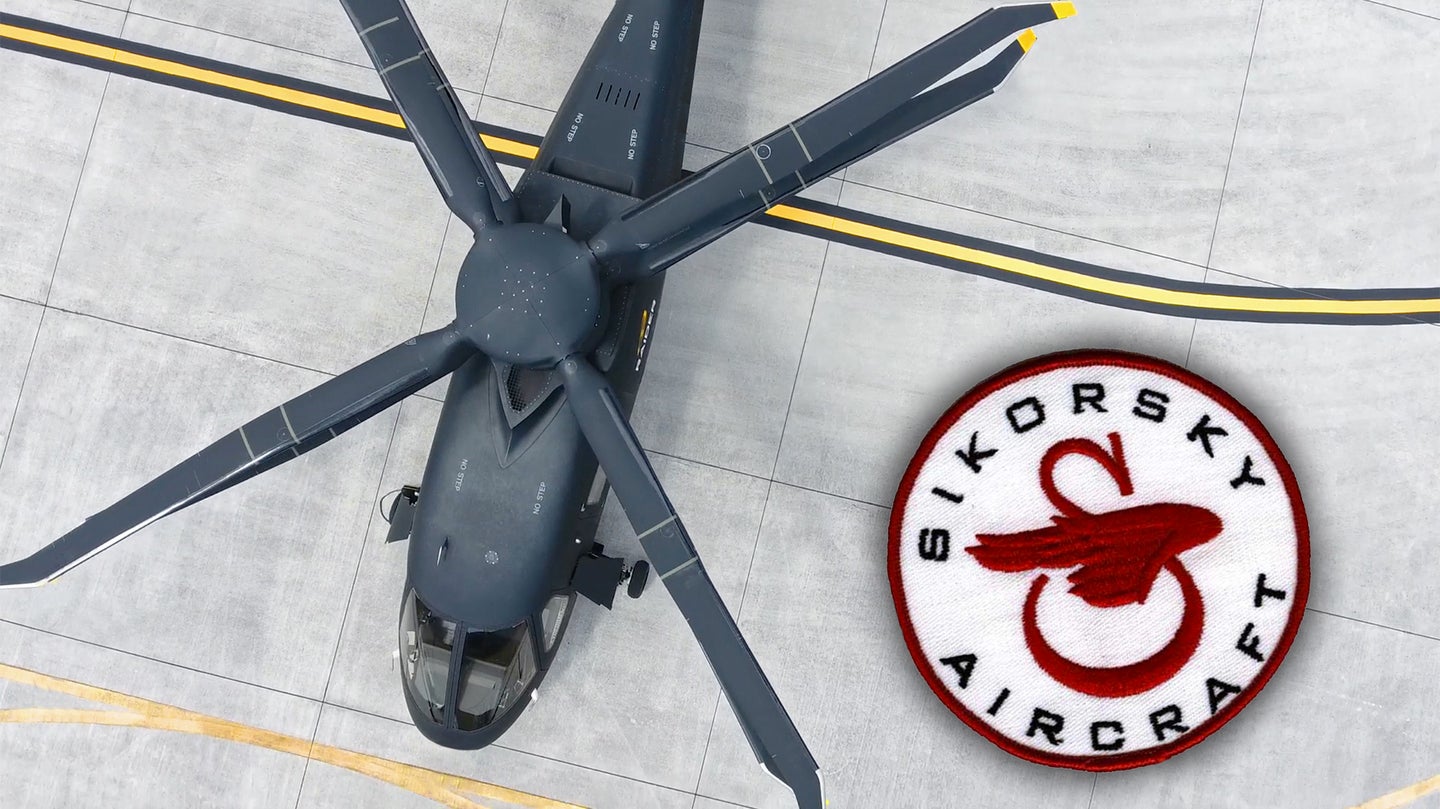
When it comes to the U.S. military, the very idea of what vertical lift is and what type of aircraft fulfills those roles is slated to drastically change in the coming decades. So much is on the line when it comes to redefining the performance and capabilities of the Pentagon's helicopter portfolio with the Future Armed Reconnaissance Aircraft (FARA), Future Long Range Assault Aircraft (FLRAA), and other future multi-faceted Future Vertical Lift (FVL) tenders on the horizon, and others, as well. Whoever wins any of these competitions will be in the driver's seat when it comes to expanding their proprietary technologies across the Department of Defense and well into the middle part of the 21st Century. Sikorsky, now owned by Lockheed Martin, is in a very interesting position to potentially lead on many fronts in this regard after investing millions in corporate funds into its high-performance X2 helicopter technology over the better part of two decades.
Still, the storied Black Hawk manufacturer has some stiff competition, including from its longtime rival Bell, for both the FLRAA and FARA contracts, while other players are also coming to the table with potentially attractive concepts of varying maturity and complexity that are likely to clock in at a wide range of price points. With the stakes so high, The War Zone reached out to Sikorsky, just as we did with Bell, to get their direct take at the highest levels on many questions surrounding their exciting new aircraft, the competitions that lie ahead, and the future of vertical lift in general.
A remarkably accomplished group of folks over at Sikorsky fielded our questions, including Tim Malia, Director of Sikorsky Future Vertical Lift—Light. Bill Fell, senior experimental test pilot for Sikorsky's S-97 and joint multi-role programs, also joined in. And last, but certainly not least, Chris Van Buiten, Vice President, Sikorsky Innovations. Here are those exchanges in full:
What makes the S-97, and its X2 Technology that Sikorsky pioneered, different than a normal helicopter?
Bill Fell: "The X2 is different in that the two rotors are used to balance lift required between the upper and lower discs. By limiting the lift that is required on the retreating side of the disc, we eliminate the aerodynamic speed limit of other rotorcraft known as retreating blade stall. This lift distribution results in a lift imbalance on each individual rotor that is overcome by making the rotors extremely rigid. This rigidity has the added benefit of provide enormous control power for combat maneuvering tactics. Producing most of the lift on the advancing half of the disc means the blades are operating at a very low angle of incidence, resulting in less drag and more load factor capability."
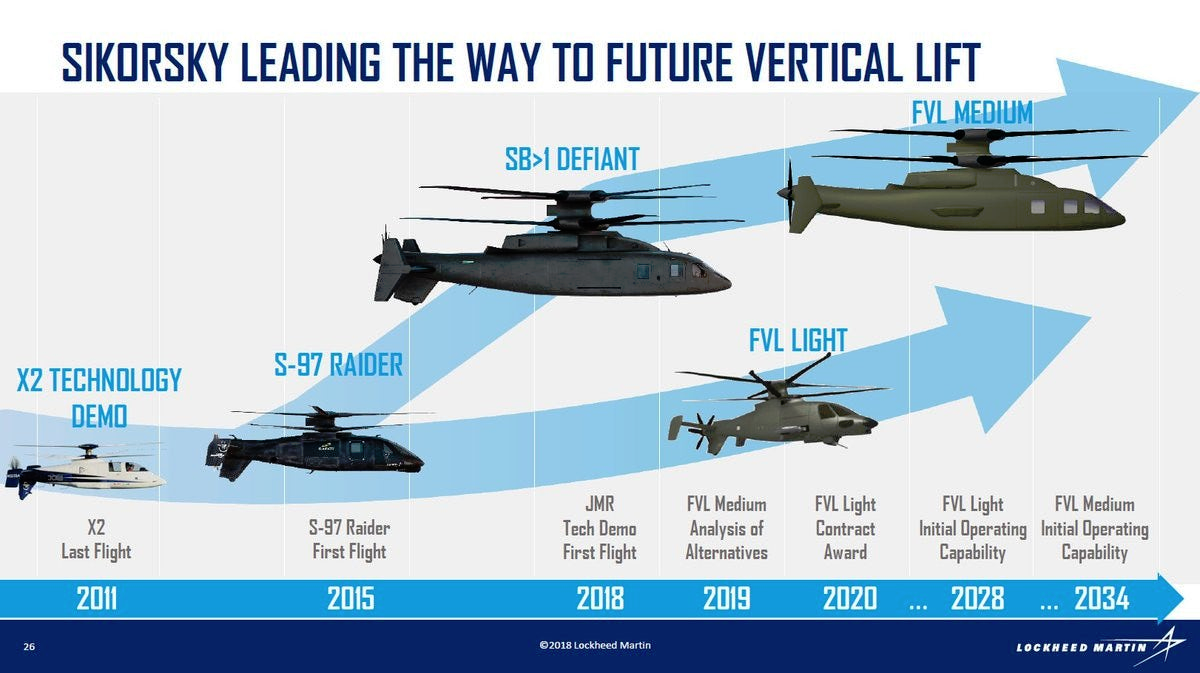
Some of the terminologies has changed and the schedule has shifted a bit, but this graphic gives a good overview of the evolution of Sikorsky's X2 technology.
Is the S-97 RAIDER a technology demonstrator or is Sikorsky looking to push the design directly into production? What informed the design’s unique mix of capabilities?
Tim Malia: "First, I’d like to say that Sikorsky is proud to have been awarded a contract to design a Future Attack Reconnaissance Aircraft [FARA] prototype. This is the culmination of years of investment in the X2 Technology Demonstrator and the S-97 RAIDER aircraft that have proven the advanced technology and shown its ability to change the future battlefield. The FARA mission is critical to our nation's defense as our near-peer adversaries continue to improve their capabilities. FARA will plug a critical gap in the Army force structure that requires revolutionary technology and not just incremental improvements to existing platforms.
The original X2 Technology Demonstrator was developed to prove the advancing blade concept was going to unlock speed and maneuverability and increase the survivability under battle conditions. The S-97 RAIDER was a step up from the original demonstrator to make more production representative to get full mission envelope testing. While still considered a demonstrator, its utility expands to include several critical attributes of interest to the Army. We continue to fly the S-97 RAIDER to inform the design for FARA, which provides significant risk reduction to the program schedule and technical objectives. We are eager to continue to support the U.S. Army, and we are excited that the Sikorsky FARA X2 will be ready for this critical mission.
The term X2 Technology refers to a suite of technologies developed by Sikorsky that enable the X2 aircraft to operate at high speed while improving operational capability, maneuverability, agility, survivability, and lethality at the landing zone."
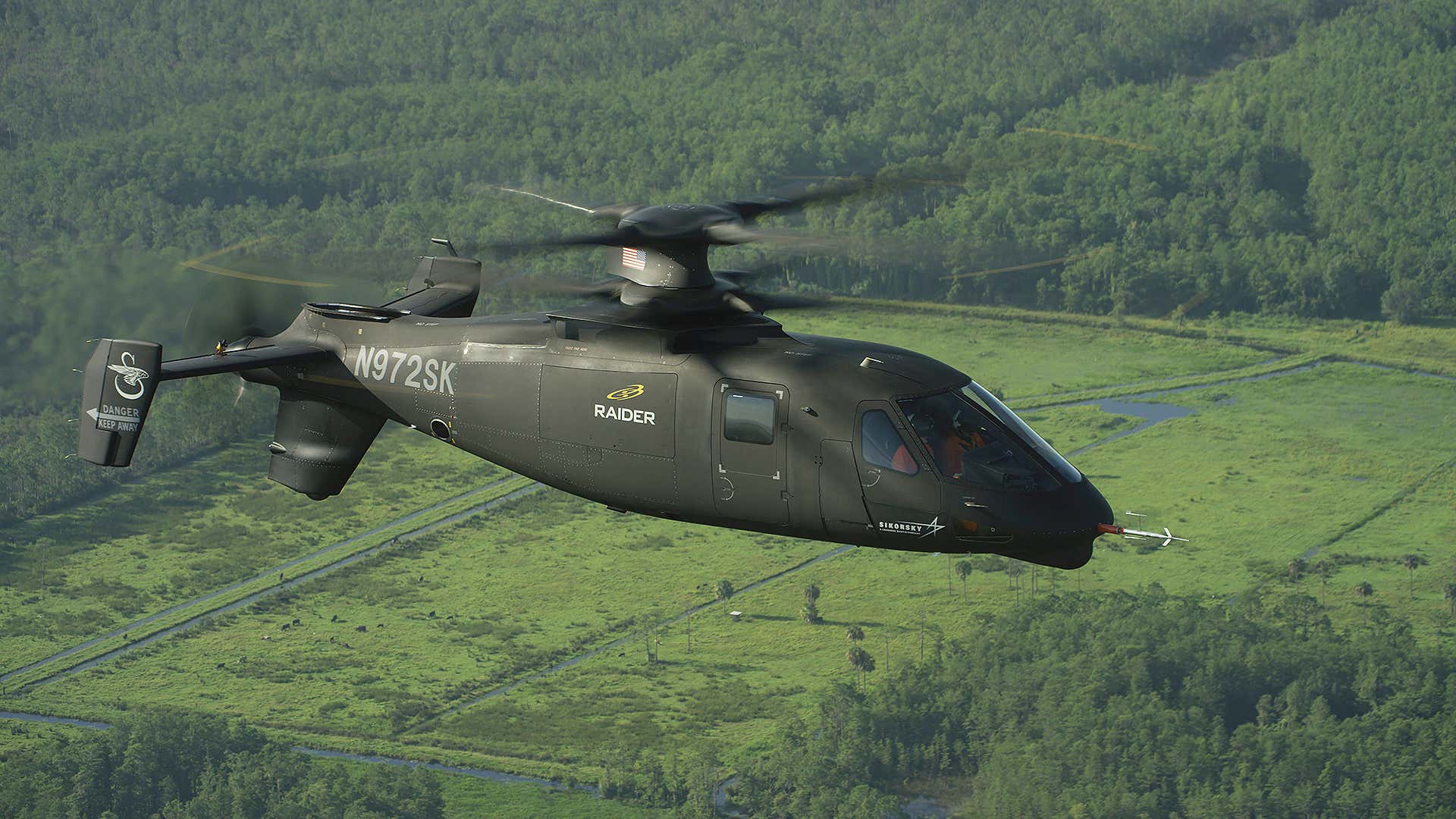
Have there been certain technological hurdles that have been especially challenging to get over during the S-97’s development?
Tim Malia: "When we started working on X2 Technology, we were focused on designing for speed, maneuverability, and scalability. The X2 Technology Demonstrator made significant improvements in vibration reduction, weight reduction, and blade technology. The rigid coaxial blades help maintain lift and stability at high speeds. We took many of our lessons learned in the design and flight test of the X2 Technology Demonstrator into RAIDER and the Sikorsky-Boeing SB>1 DEFIANT. The process was a logical technical maturation.
The X2 technology demonstrator proved the physics—speed, vibes, and workload. The technology won the Collier award and the demonstrator was put in the Smithsonian. The X2 had a gross weight of 6,000 pounds, RAIDER grows to double the gross weight and adds operational features. DEFIANT grows the gross weight to above 30,000 pounds to demonstrate the long-range, 12-troop transport capability."
Can you give us some approximate performance targets for the S-97 and the SB>1?
Bill Fell: "RAIDER is designed to be a 220-230 knot aircraft in level flight. We have achieved 202 knots and will soon push the envelope even more. RAIDER has been test flown at weights of ranging from about 9,500 to 11,000 pounds. DEFIANT is a larger aircraft in excess of 25,000 pounds with more payload, speed capability, and range."
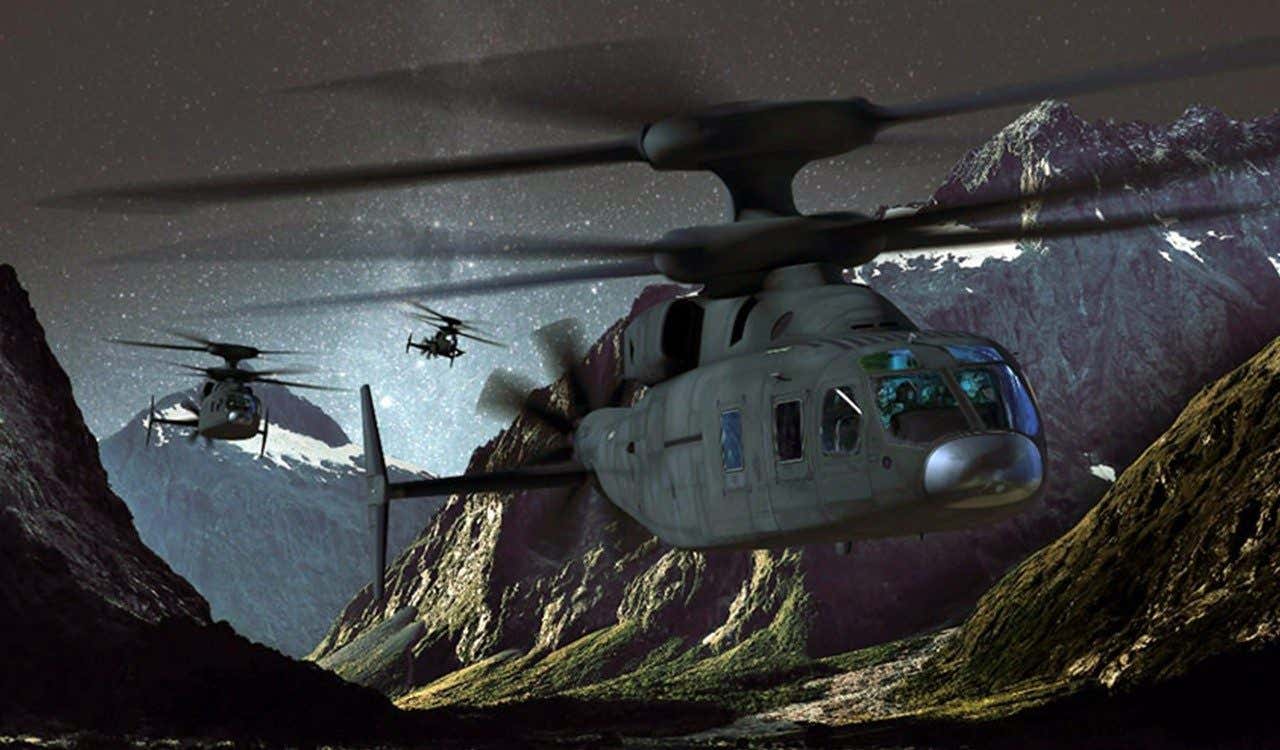
SB>1 concept art.
Cost should be a major factor for the Future Vertical Lift tender. How much more expensive will this more complex, fast-flying design be than say one of your UH-60 Black Hawks that continue to roll off the line today? What about the cost to operate it over time?
Tim Malia: "I think the first point to clarify is that our X2-based FARA is not more complex than a BLACK HAWK. In fact, despite having two main rotors, there are one-half the total parts in the S-97 RAIDER rotor head than on a BLACK HAWK. This reduction in complexity and part count saves money from a sustainment perspective with less parts to maintain and spare. To that end, the rigid rotor system no longer has flapping and lead/lag modes which eliminates the dampers that are a routine maintenance element on a BLACK HAWK.
I’d also add that the development of X2 Technology and the RAIDER program has been funded entirely by significant investments by Sikorsky, Lockheed Martin, and industry partners. As we have made those investments, it has been to change the way we do vertical lift—decrease life-cycle costs, eliminate maintenance burdens. We will provide revolutionary aircraft that not only change the way that we fly our missions and reducing the maintenance requirements that traditional rotorcraft have historically provided. We don’t have to make compromises with X2.
The other big-picture benefit of X2 will become apparent as the Army looks across their vertical lift inventory. X2 is the only scalable technology on the table for the Army to consider in their diverse missions. The Army today has three very different aircraft types to maintain, support, and grow capability through technology insertions. Tomorrow they could all reside on the X2 platform, scaled to serve the three very different mission sets. As you look at having X2 in both the Attack/Recon and the Utility/Long Range Assault FVL variants, you can start to envision maintenance and flight training commonality across the entire fleet. When the attack replacement occurs, they can be on the common technology platform across the service. This is an enormous opportunity for the Army to reduce future costs of operations. With the fiscal constraints across the Army, this will be a very welcome change."

SB>1 DEFIANT in flight.
In regards to maintenance, how will servicing the S-97 or the SB>1 be different than a traditional helicopter with equal capacity?
Chris Van Buiten: "The most significant servicing difference between the Rigid Coaxial design and a traditional helicopter is that the rigid rotor does not have Main Rotor Dampers. Dampers are typically the highest maintenance items on a helicopter and we do not need them. Other than that, the complexity and supportability is similar. On our next generation of aircraft, the big difference will come from the advanced diagnostic and prognostic systems both onboard and off-board that optimize system maintenance to control costs and maximize availability."

SB>1 DEFIANT.
How does a pilot fly the S-97? In other words, how does the aircraft operate different from traditional helicopters from a pilot’s perspective?
Bill Fell: "RAIDER can be flown the same as every other rotorcraft when the prop is disengaged via a clutch. The rotor is controlled through both a cyclic and collective. When the prop is engaged the pilot releases the collective around 100-knots as the flight control computer (FCC) programs the collective down with increasing speed. RAIDER is flown like an airplane above 100 knots with speed increased by increasing prop pitch via a beeper switch on the collective. In this mode, RAIDER climbs by pointing the nose up and adding prop or lowering the nose to descend. The collective is still functional in high-speed flight such that the pilot can increase the collective to climb but using the prop tends to be more efficient."
Chris Van Buiten: "There is room for both if some of the missions do not require the maneuverability, agility, and other attributes that enable terminal area survivability (surviving at the landing zone). If there are long-range “school bus” missions, we are not focused on them.
Our focus is to provide game-changing capability that is achieved by integrating familiar technologies in a new way. It is important to our team to design an aircraft that will retain what our customers love about a BLACK HAWK while giving them huge advances in speed, efficiency, maneuverability, and survivability."
What military variants of this compound coaxial helicopter concept do you see as being feasible? How large can it scale up to?
Chris Van Buiten: "We see a wide spectrum of variants including special operations, recon, attack, assault, Naval, SAR, and VIP. The technology scales. The X2 Technology Demonstrator was 6,000 lb gross weight, RAIDER is 12,000, and DEFAINT is 32,000 lb gross weight. We have executed a study contract looking at a 100,000 lb variant of this configuration."
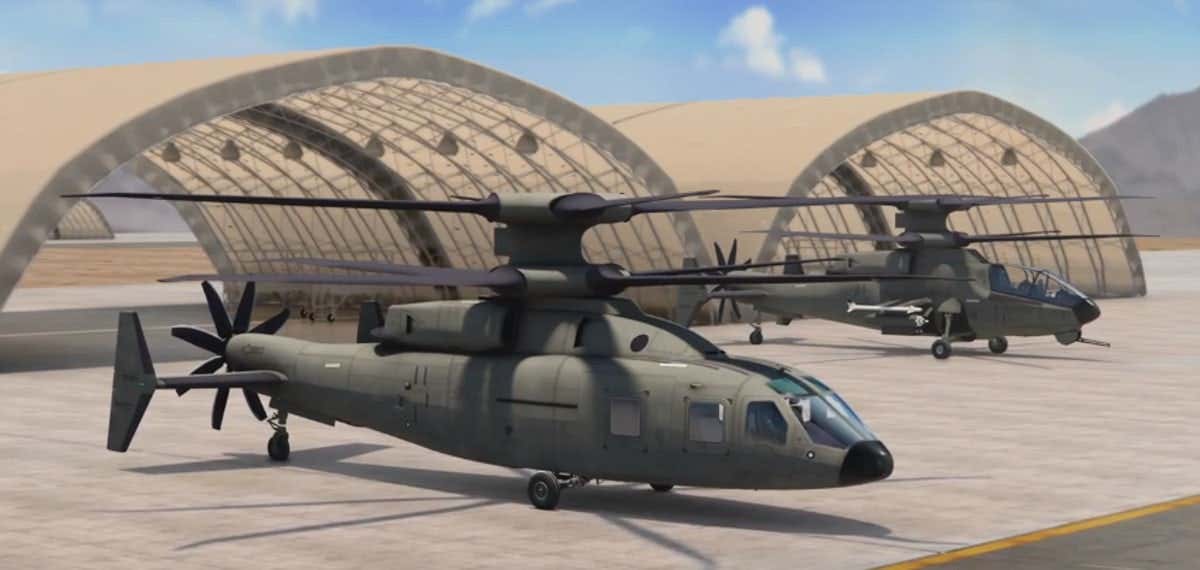
Concept art showing the SB>1 next to a gunship variant, both of which could satisfy the Army's Future Vertical Lift requirement.
There is a lot of confusion about the Raider’s low-observable (stealth) qualities, or lack thereof. Can you set the record straight when it comes to the design’s radar signature? What about its infrared and acoustic signatures?
Tim Malia: "We can’t comment specifically about any classified elements of the design or operation in the intended environment. We are focused on the future battle and future adversaries and providing the technology that maximizes the survivability of the platform and the crew. This is a crucial mission. It is at the front lines and into enemy territory, and it takes a platform with both the speed and agility as well as onboard systems and sensors to operate in a contested A2AD environment. We are able to leverage the full strength of Lockheed Martin to provide a solution that will change the way we fight and win any future conflicts."
Have elements of the aborted RAH-66 Comanche program carried over to the S-97 or any other Sikorsky program?
Chris Van Buiten: "While we are not using any specific Comanche parts, some of the technologies and processes from Comanche are being used."
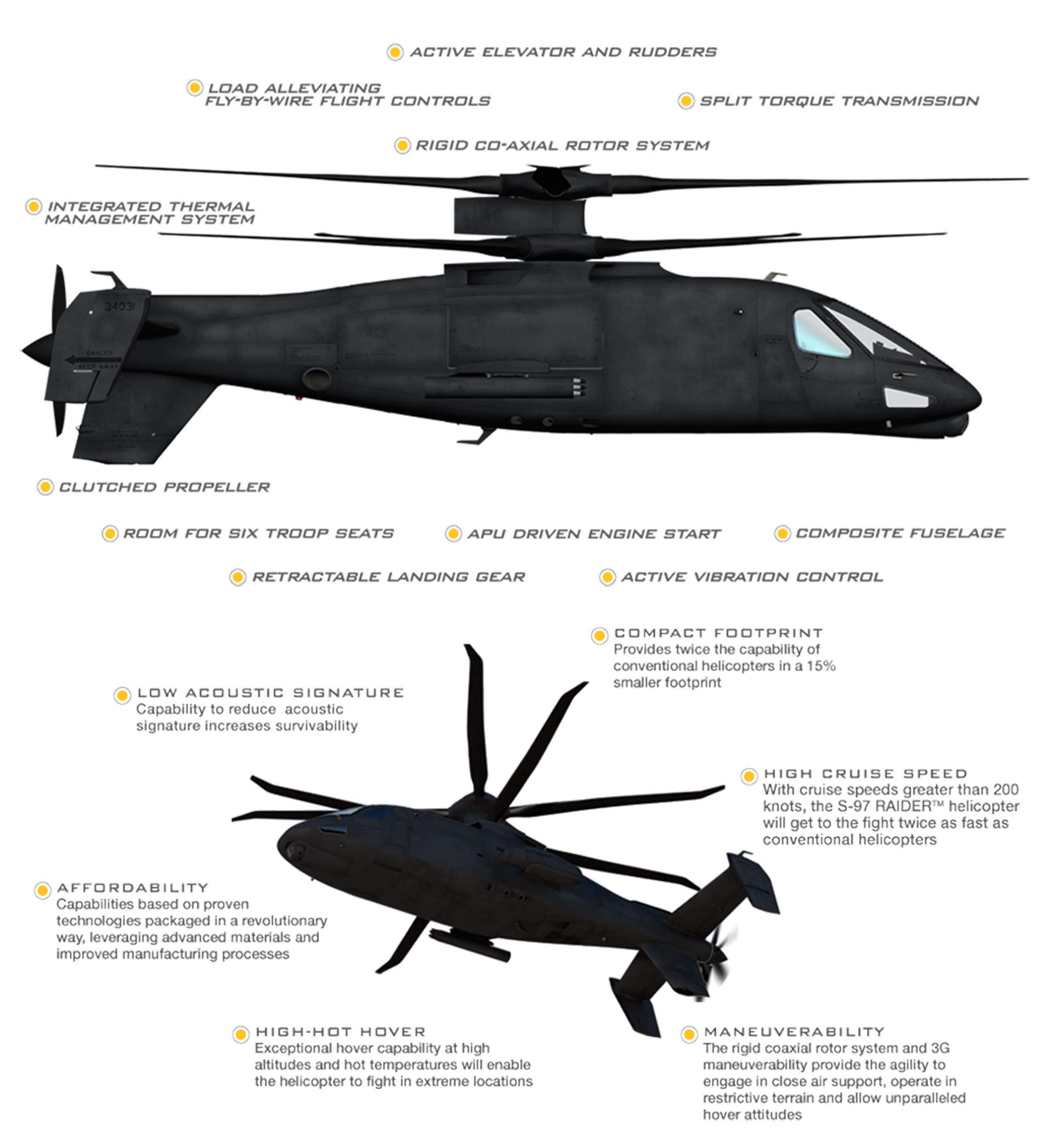

When it comes to the U.S. military, the very idea of what vertical lift is and what type of aircraft fulfills those roles is slated to drastically change in the coming decades. So much is on the line when it comes to redefining the performance and capabilities of the Pentagon's helicopter portfolio with the Future Armed Reconnaissance Aircraft (FARA), Future Long Range Assault Aircraft (FLRAA), and other future multi-faceted Future Vertical Lift (FVL) tenders on the horizon, and others, as well. Whoever wins any of these competitions will be in the driver's seat when it comes to expanding their proprietary technologies across the Department of Defense and well into the middle part of the 21st Century. Sikorsky, now owned by Lockheed Martin, is in a very interesting position to potentially lead on many fronts in this regard after investing millions in corporate funds into its high-performance X2 helicopter technology over the better part of two decades.
Still, the storied Black Hawk manufacturer has some stiff competition, including from its longtime rival Bell, for both the FLRAA and FARA contracts, while other players are also coming to the table with potentially attractive concepts of varying maturity and complexity that are likely to clock in at a wide range of price points. With the stakes so high, The War Zone reached out to Sikorsky, just as we did with Bell, to get their direct take at the highest levels on many questions surrounding their exciting new aircraft, the competitions that lie ahead, and the future of vertical lift in general.
A remarkably accomplished group of folks over at Sikorsky fielded our questions, including Tim Malia, Director of Sikorsky Future Vertical Lift—Light. Bill Fell, senior experimental test pilot for Sikorsky's S-97 and joint multi-role programs, also joined in. And last, but certainly not least, Chris Van Buiten, Vice President, Sikorsky Innovations. Here are those exchanges in full:
What makes the S-97, and its X2 Technology that Sikorsky pioneered, different than a normal helicopter?
Bill Fell: "The X2 is different in that the two rotors are used to balance lift required between the upper and lower discs. By limiting the lift that is required on the retreating side of the disc, we eliminate the aerodynamic speed limit of other rotorcraft known as retreating blade stall. This lift distribution results in a lift imbalance on each individual rotor that is overcome by making the rotors extremely rigid. This rigidity has the added benefit of provide enormous control power for combat maneuvering tactics. Producing most of the lift on the advancing half of the disc means the blades are operating at a very low angle of incidence, resulting in less drag and more load factor capability."

Some of the terminologies has changed and the schedule has shifted a bit, but this graphic gives a good overview of the evolution of Sikorsky's X2 technology.
Is the S-97 RAIDER a technology demonstrator or is Sikorsky looking to push the design directly into production? What informed the design’s unique mix of capabilities?
Tim Malia: "First, I’d like to say that Sikorsky is proud to have been awarded a contract to design a Future Attack Reconnaissance Aircraft [FARA] prototype. This is the culmination of years of investment in the X2 Technology Demonstrator and the S-97 RAIDER aircraft that have proven the advanced technology and shown its ability to change the future battlefield. The FARA mission is critical to our nation's defense as our near-peer adversaries continue to improve their capabilities. FARA will plug a critical gap in the Army force structure that requires revolutionary technology and not just incremental improvements to existing platforms.
The original X2 Technology Demonstrator was developed to prove the advancing blade concept was going to unlock speed and maneuverability and increase the survivability under battle conditions. The S-97 RAIDER was a step up from the original demonstrator to make more production representative to get full mission envelope testing. While still considered a demonstrator, its utility expands to include several critical attributes of interest to the Army. We continue to fly the S-97 RAIDER to inform the design for FARA, which provides significant risk reduction to the program schedule and technical objectives. We are eager to continue to support the U.S. Army, and we are excited that the Sikorsky FARA X2 will be ready for this critical mission.
The term X2 Technology refers to a suite of technologies developed by Sikorsky that enable the X2 aircraft to operate at high speed while improving operational capability, maneuverability, agility, survivability, and lethality at the landing zone."

Have there been certain technological hurdles that have been especially challenging to get over during the S-97’s development?
Tim Malia: "When we started working on X2 Technology, we were focused on designing for speed, maneuverability, and scalability. The X2 Technology Demonstrator made significant improvements in vibration reduction, weight reduction, and blade technology. The rigid coaxial blades help maintain lift and stability at high speeds. We took many of our lessons learned in the design and flight test of the X2 Technology Demonstrator into RAIDER and the Sikorsky-Boeing SB>1 DEFIANT. The process was a logical technical maturation.
The X2 technology demonstrator proved the physics—speed, vibes, and workload. The technology won the Collier award and the demonstrator was put in the Smithsonian. The X2 had a gross weight of 6,000 pounds, RAIDER grows to double the gross weight and adds operational features. DEFIANT grows the gross weight to above 30,000 pounds to demonstrate the long-range, 12-troop transport capability."
Can you give us some approximate performance targets for the S-97 and the SB>1?
Bill Fell: "RAIDER is designed to be a 220-230 knot aircraft in level flight. We have achieved 202 knots and will soon push the envelope even more. RAIDER has been test flown at weights of ranging from about 9,500 to 11,000 pounds. DEFIANT is a larger aircraft in excess of 25,000 pounds with more payload, speed capability, and range."

SB>1 concept art.
Cost should be a major factor for the Future Vertical Lift tender. How much more expensive will this more complex, fast-flying design be than say one of your UH-60 Black Hawks that continue to roll off the line today? What about the cost to operate it over time?
Tim Malia: "I think the first point to clarify is that our X2-based FARA is not more complex than a BLACK HAWK. In fact, despite having two main rotors, there are one-half the total parts in the S-97 RAIDER rotor head than on a BLACK HAWK. This reduction in complexity and part count saves money from a sustainment perspective with less parts to maintain and spare. To that end, the rigid rotor system no longer has flapping and lead/lag modes which eliminates the dampers that are a routine maintenance element on a BLACK HAWK.
I’d also add that the development of X2 Technology and the RAIDER program has been funded entirely by significant investments by Sikorsky, Lockheed Martin, and industry partners. As we have made those investments, it has been to change the way we do vertical lift—decrease life-cycle costs, eliminate maintenance burdens. We will provide revolutionary aircraft that not only change the way that we fly our missions and reducing the maintenance requirements that traditional rotorcraft have historically provided. We don’t have to make compromises with X2.
The other big-picture benefit of X2 will become apparent as the Army looks across their vertical lift inventory. X2 is the only scalable technology on the table for the Army to consider in their diverse missions. The Army today has three very different aircraft types to maintain, support, and grow capability through technology insertions. Tomorrow they could all reside on the X2 platform, scaled to serve the three very different mission sets. As you look at having X2 in both the Attack/Recon and the Utility/Long Range Assault FVL variants, you can start to envision maintenance and flight training commonality across the entire fleet. When the attack replacement occurs, they can be on the common technology platform across the service. This is an enormous opportunity for the Army to reduce future costs of operations. With the fiscal constraints across the Army, this will be a very welcome change."

SB>1 DEFIANT in flight.
In regards to maintenance, how will servicing the S-97 or the SB>1 be different than a traditional helicopter with equal capacity?
Chris Van Buiten: "The most significant servicing difference between the Rigid Coaxial design and a traditional helicopter is that the rigid rotor does not have Main Rotor Dampers. Dampers are typically the highest maintenance items on a helicopter and we do not need them. Other than that, the complexity and supportability is similar. On our next generation of aircraft, the big difference will come from the advanced diagnostic and prognostic systems both onboard and off-board that optimize system maintenance to control costs and maximize availability."

SB>1 DEFIANT.
How does a pilot fly the S-97? In other words, how does the aircraft operate different from traditional helicopters from a pilot’s perspective?
Bill Fell: "RAIDER can be flown the same as every other rotorcraft when the prop is disengaged via a clutch. The rotor is controlled through both a cyclic and collective. When the prop is engaged the pilot releases the collective around 100-knots as the flight control computer (FCC) programs the collective down with increasing speed. RAIDER is flown like an airplane above 100 knots with speed increased by increasing prop pitch via a beeper switch on the collective. In this mode, RAIDER climbs by pointing the nose up and adding prop or lowering the nose to descend. The collective is still functional in high-speed flight such that the pilot can increase the collective to climb but using the prop tends to be more efficient."
Chris Van Buiten: "There is room for both if some of the missions do not require the maneuverability, agility, and other attributes that enable terminal area survivability (surviving at the landing zone). If there are long-range “school bus” missions, we are not focused on them.
Our focus is to provide game-changing capability that is achieved by integrating familiar technologies in a new way. It is important to our team to design an aircraft that will retain what our customers love about a BLACK HAWK while giving them huge advances in speed, efficiency, maneuverability, and survivability."
What military variants of this compound coaxial helicopter concept do you see as being feasible? How large can it scale up to?
Chris Van Buiten: "We see a wide spectrum of variants including special operations, recon, attack, assault, Naval, SAR, and VIP. The technology scales. The X2 Technology Demonstrator was 6,000 lb gross weight, RAIDER is 12,000, and DEFAINT is 32,000 lb gross weight. We have executed a study contract looking at a 100,000 lb variant of this configuration."

Concept art showing the SB>1 next to a gunship variant, both of which could satisfy the Army's Future Vertical Lift requirement.
There is a lot of confusion about the Raider’s low-observable (stealth) qualities, or lack thereof. Can you set the record straight when it comes to the design’s radar signature? What about its infrared and acoustic signatures?
Tim Malia: "We can’t comment specifically about any classified elements of the design or operation in the intended environment. We are focused on the future battle and future adversaries and providing the technology that maximizes the survivability of the platform and the crew. This is a crucial mission. It is at the front lines and into enemy territory, and it takes a platform with both the speed and agility as well as onboard systems and sensors to operate in a contested A2AD environment. We are able to leverage the full strength of Lockheed Martin to provide a solution that will change the way we fight and win any future conflicts."
Have elements of the aborted RAH-66 Comanche program carried over to the S-97 or any other Sikorsky program?
Chris Van Buiten: "While we are not using any specific Comanche parts, some of the technologies and processes from Comanche are being used."




